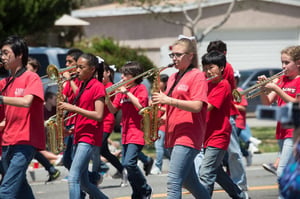 You’re in charge of a K-12 arts education curriculum, and you’ve navigated those tricky waters of obtaining funding for your programs. Congratulations. Now, all you have to do is attract students to participate in these classes on which you have worked so hard to get off the ground.
You’re in charge of a K-12 arts education curriculum, and you’ve navigated those tricky waters of obtaining funding for your programs. Congratulations. Now, all you have to do is attract students to participate in these classes on which you have worked so hard to get off the ground.
Music class is still a part of the early elementary school curriculum, but time in music class has generally decreased – many young students receive only about a half-hour of music instruction each week. Some schools have choirs, which adds music time for those who participate. The 30 minutes of music education equal that devoted to art, library and, in some cases, phys ed.
The key is generating interest in music so that these children want to continue their music careers into middle school and beyond, when music classes become an elective. This is the time when music becomes participatory and can be transformed into a fun extracurricular activity. Choirs, bands and orchestras can provide training on an instrument or two, a chance to join a group and opportunities to make lifetime friendships.
Here are some ways to help students appreciate the value of music education:
- Make elementary classes exciting: If a student is singing the same old songs, or playing the same old exercises on the recorder every week, class will be boring. Connolly Music’s String Ovation website links to some online resources that can help make music class fun for young students. Another trick: Help the class decode a currently popular (family friendly) song, which will teach the children some basic music theory as they bop to the beat.
- Encourage parental advocacy: Now, the parents don’t have to tell their kids all this, but Mom and Dad should be made aware that, according to Music School Central, studies have found that music education can lead to higher IQ, help protect against eventual dementia, improve emotional outlook, improve grade-point average, enhance social skills, increase reading ability, sharpen cognitive function, improve motor skills and – the one parents might want to share with the kiddos – allows people to express themselves and develop a personal style.
- Translate learning: While most people aren’t born with perfect pitch or who may not possess the innate rhythm of Michael Jackson, that doesn’t mean they can’t learn how to be a musician in an in-class or after school program. Students with strong math skills can translate those into figuring out beats and tempos. Those with good hand-eye coordination can easily become excellent sight-readers, and the beat goes on.
- Increase visibility: Seek support from principals, department heads, school boards and district administrators. The Vault at Musicarts.com suggests music educators initiate an annual recruiting day, in which local professionals, instrument dealers and students perform and demonstrate instruments for elementary schools in a middle school’s feeder system. The middle school teachers can even visit the feeder elementaries occasionally, or involve promising younger students in a late-school-year performance – high school bands do that with upcoming eighth-graders all the time. Booster organizations also can get in on the recruiting action.
- Engage ambassadors: The Vault also suggests having older students serve as “ambassadors” to the younger students. The elementary kids see how much those cool middle-schoolers like making music and maybe can develop a mentor-protégé relationship. The older students may even be able to earn community service credit.
- Involve the community: This goes along with increasing visibility, but on an external level, rather than internally within the school district. The musical organizations, such as choirs, bands and orchestras, can participate in community fairs, parades and other public events. These functions also involve opportunities to meet parents and future students, and possibly private instructors who might steer their students to school programs. And – they are also opportunities to get in touch with local businesses who could provide sponsorship for concerts.
Almost everyone starts listening to music at a young age, but creating stimulation for wanting to learn music is often a challenge. Tips like the ones above can help music teachers clear those hurdles and build programs that will last for years.









